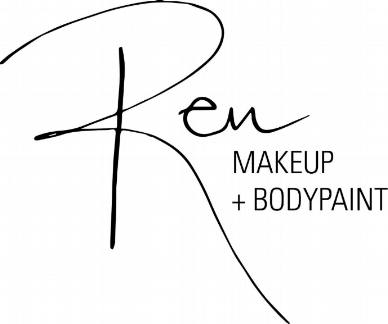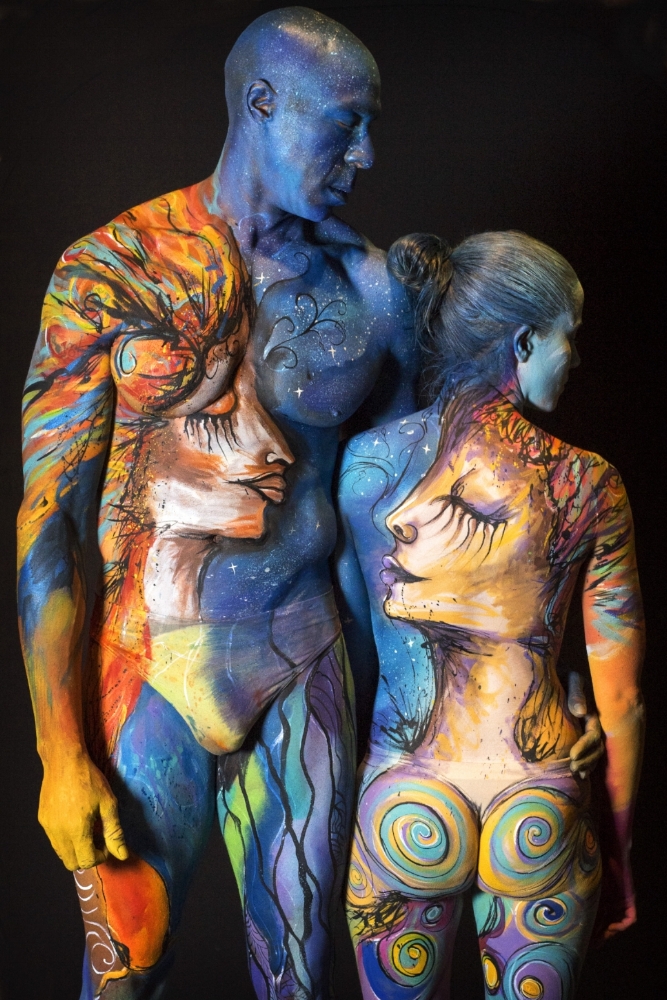NOTE: Please do not use anything on humans that is not tested for, and safe for skin. All of these paints listed are cosmetic grade paints, with the exception of a few by Kryolan that are for use on prosthetics.
Products that are listed as "Non-toxic" are NOT approved for cosmetic use.
Further, if you plan to use a product in the eye or lip area, it should be specifically approved for use in that area.
Acrylic paint is not safe for human skin. Please only use skin-safe paints and do your research.
Photo by Keith Dixon Studios, models D'yon Holmes and Brenna McBroom.
I get a ton of questions about what kind of paint and tools I use for bodypainting. So this is written with the intent of answering those questions, and giving people some links and information they may find helpful, whether you're interested in face/bodypainting, or just have a special photo shoot or event.
I'm going to start with the water-soluble cake paints I use. These are activated with water and a paintbrush or sponge. They are one of the paints I use most commonly, as I tend to basecoat with them even when airbrushing. I use these for facepaint most often as well.
The cake paints are not waterproof though, so any underwater or high-stress painting conditions (heat/performance/humidity), these will not work for.
Favorite water-soluble cake paints in my kit:
Cameleon Paints based out of Europe, and with a US distributor. These paints come in regular colors, UV reactive paints, and shimmering metallics. I love the consistency for both base coating and line work. The brilliant pigmentation never disappoints. They also make some split cakes that are indispensable for face painting work.
Other products I adore by Cameleon, include their foaming soap for removal of body paint. It's an incredibly gentle soap that really helps loosen bodypaint when the day is over.
The US site also carries great paints, glitters, and face/bodypainting products made by other companies. I have several of their brushes and they are wonderful, low-cost brushes to keep in your kit.
Mehron Paradise AQ paints, based out of NYC are a staple in most every face/bodypainting kit. Most of their regular line is a very creamy, smooth paint that dries to a matte finish. They do carry some beautiful metallics as well though. These paints are utterly reliable for the most smooth base coats. They also carry several split cakes that are larger. The coconut smell is a bonus!
Other products by Mehron that I adore...the metallic loose pigments, combined with their liquid mixing medium for the most skin-safe metallic paint ever. We used this product combo on Seth Avett for the Avett Brothers Halloween 2014 concert in Asheville NC, when he was dressed as the tin man from "Wizard of Oz". This paint holds up under adverse conditions, looks like metal, and is cosmetic grade. Makes great accents over other paints as well.
My favorite brushes by Mehron are the Mark Reid series, as well as his gel "Glittermark" adhesive glitters. The gold and silver in that line are fabulous.
They also make a product called "Detailz" that allow for very quick, easy dots and fine detail work. It's a felt tip wand, soaked in paint in a small take-along bottle, which allows for the best dots you've ever made in seconds.
Be sure to browse around the Paradise AQ products as they carry both individual cakes, as well as pre-made palettes and kits.
Other excellent brands include Diamond FX, Kryolan, and FAB. All of these paints and more, can be found at one of my favorite distributors, Silly Farm.
Silly Farm is run by some of the most helpful, kind humans, who are movers and shakers in the face/bodypaint world. They offer up some great tutorial videos, as well as more products than you can fathom.
Their Paint Pal brushes are the bomb! I also purchase all of my disposable thongs and pasties through them (Monster pasties are the BEST) and can count on them to be super helpful when I have any questions or special requests.
They sell any and all sponges you would ever need for any project, as well as beautiful glitters!
Moving on to airbrush products!
Airbrushing is one of the best tools/techniques for bodypainting in my opinion. What it creates in frustration over maintenance of tools/equipment, it makes up for in control and beauty.
I have a lot to learn about airbrushing, but here is what I personally use. I highly recommend spending time learning about different artists and techniques as I tend to be a bit of an outlier regarding the kind of brushes I use. Most artists who are really skilled at airbrush techniques use siphon feed brushes, I prefer gravity feed and I just can't make myself love the siphon feed, though they definitely have their uses.
All of my airbrushes for bodypainting at this point, are Iwata Eclipse gravity feed. I have eight of them, with a quick-release system attached so I can easily switch brushes with one hose attachment. My compressor is the Aspire Pro by Badger.
The main paint I use for airbrush is the Olive Branch Skincare hybrid paint. I've tried others, but nothing compares to their durability, opacity, pigmentation, and color selection.
This is the paint used exclusively for our underwater work, including all of the Serenity project (for Metavivor Research and Support) paintings/underwater photo shoots.
This airbrush liquid can also be applied by hand, but give yourself time to adjust to the consistency and remember that you always clean waterproof/hybrid paints with 91 or 99% rubbing alcohol! No water!
There is a high opacity waterproof cake paint created by artist Tiffany Beckler now available at Body Color Cosmetics. I especially love the "Ren Yellow". ;) This is an extremely durable product activated by the mixing medium they also sell. Definitely check these out.
That's a quick synopsis of products and tools I use....remember to experiment and try new things always. If you're looking for information about techniques, there are loads of videos out there and great support/videos/education at Faba TV.
Leave a comment if you have any questions, and happy painting!
This ad by Proaiir features artist John Allen Poppleton (UV light/dolphin art) and my art (top right) on model Angela Rene Roberts, photographed by Keith Dixon Studios.
UV/Blacklight bodypaints
The important thing to know is that while there are UV reactive paints, there are not glow-in-the-dark paints that are safe for skin/cosmetic grade. People ask about these frequently, but I do not know of anything safe for human skin at this time. I recommend using fabric paint and painting bodysuits if these effect is needed.
Just keep in mind that glow-in-the-dark paints need to be charged up with bright lights for a period of time, and then they will slowly lose their glow after that. They also look best in complete dark, which is not ideal for most performance/event uses. Color differentiations are very subtle as well, and the most common paint has a light green glow effect.
In order to get the glow effect of a UV/blacklight paint, you will need UV/blacklights. Any regular lighting nearby will cut the effect, so surrounding the bodypaint with blacklight is your best option.
In regular light, some of these paints add a fluorescent accent, or bright pop of color, but you will only get the glow effect under blacklights. Many UV bodypaints look washed out or plain under regular light, but have a wonderful effect when lit properly.
My favorites include cake paints by Cameleon, Fab, Tag, and Kryolan. Many of these can be purchased at the Sillyfarm website linked above.
The airbrush paints I use are all by Proaiir. There's are the brightest/most intense under regular light, out of all the blacklight paints I've worked with.






